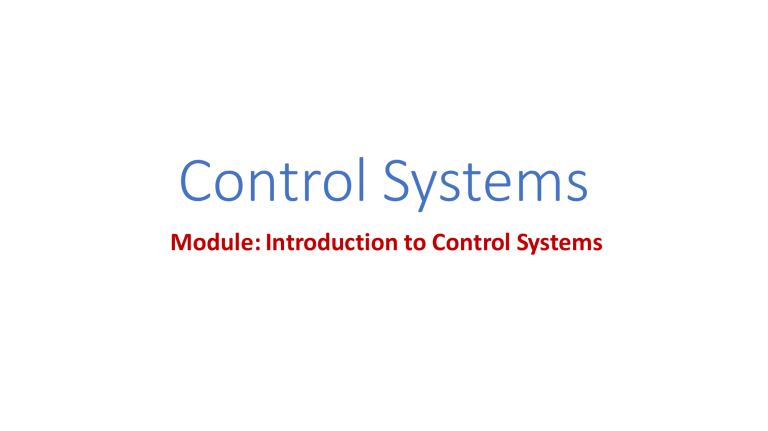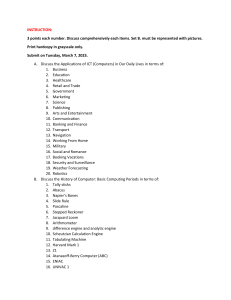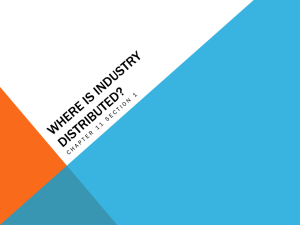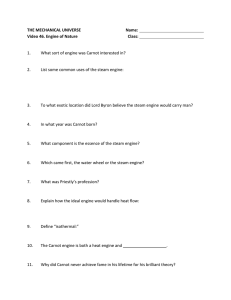
Control Systems Module: Introduction to Control Systems About me • • • M.S. & Ph.D., Department of Electrical Engineering, IIT Madras Researcher, Mobile Robotics, Addverb Technologies, Noida Operations Research Analyst, Solverminds Solutions & Tech, Chennai Research Interests: • • • • • Game theory Robotics Control & Optimization (IP/LP/MILP/Convex/Non-linear) Multi-agent Path Finding Operations Research Course Outline Module 1: Introduction to Control Systems Module 2: Mathematical Modeling of a System Module 3: Block Diagram Reduction Module 4: Time Response Analysis Module 5: Stability Analysis Module 6: Steady-State Errors Module 7: Design via State Space Module 8: Root Locus Techniques and Design via Root Locus Module 9: Frequency Response Techniques and Design via Frequency Response Module 10: Digital Control Systems Text and Reference Books Text Books: • Norman S. Nise, Control System Engineering, 7th Edition, Wiley. • Katsuhiko Ogata, Modern Control Engineering, 5th Edition, Prentice Hall. Reference Books: • Benjamin C. Kuo, Automatic Control Systems, Prentice Hall. • Richard C. Dorf and Robert H. Bishop, Modern Control Systems, Pearson. • Gene Franklin, J.D. Powell, and Abbas Emami-Naeini, Feedback Control of Dynamic Systems, Prentice Hall. • Eronini I. Umez-Eronini, System Dynamics and Control, Thomson Engineering. Assessment Assignments + Classroom Quizzes: 30% Mid-Sem Exam: 30% End-Sem Exam: 40% Outline Introduction to Control Systems: • • • • • • System & Control System Open loop and Closed loop Control systems Examples of Control Systems A brief history of Control Systems Future evolution of Control Systems Control Systems Design System/Plant/Process • A system is a collection of interrelated and interacting components that work together to achieve a particular objective or purpose. • A system generates an output (response) in response to an input (excitation). Input/ Excitation Sy Plant Output/ Response • A system may comprise multiple subsystems within its structure. Automobile and its subsystems: • Engine System: Responsible for generating power. • Braking System: Manages the vehicle's deceleration and stopping. • Electrical System: Controls lighting, instrumentation, and other electrical components. • Transmission System: Facilitates the transfer of power from the engine to the wheels. • Fuel System: Manages the storage and delivery of fuel to the engine. Examples Air conditioner •Input – Electrical energy (Voltage) •Output – Heat energy (Changes the ambient temperature) Human body infected with a virus •Input – Drug administration •Output – Drug distribution & effect on the body Vehicle •Input – Acceleration or Deceleration •Output – Vehicle displacement Motor •Input – Electrical energy (Voltage) •Output – Mechanical energy (Torque / Rotation) Control System Control system: a mechanism that alters the future state of the system. Control theory: a branch of applied mathematics that provides a strategy to select an appropriate input A control system is necessary to regulate or manage the behavior of a system or process. A control system consists of subsystems and processes (or plants) assembled for the purpose of obtaining a desired output with desired performance. Types of Control Systems Process to be Controlled: An open-loop control system utilizes an actuating device to control the process directly without • No feedback using feedback. • Cannot Tolerate Disturbances Ex. Ceiling Fan, • Lower cost and Complexity Oven, toasters. A closed-loop control system uses a measurement of the output and feedback of this signal to compare it with the desired output (reference or command). Ex. Air Conditioner An actuator physically performs the action, while a controller directs and regulates the action. • Feedback for corrective action • Robust to Disturbances • Higher cost and Complexity Examples of control systems Manual Closed loop Control system: Student–teacher learning process: Desired output: Fluid level Actuator: Valve + Human Hands Controller: Brain Sensors: Human Eyes Process: Tank Examples of Control systems Input: Reference cleanliness Control variable: Amount of time Output: Actual cleanliness after washing Disturbances: Variable cleanliness of the cloths Open loop control systems cannot correct for any disturbances. Closed loop control systems correct for any disturbances by measuring the output response, feeding that measurement back through a feedback path, and comparing the response to the input. Closed loop system Disturbance Control Input Control system Reference Plant Feedback : Measured temperature Air conditioner maintaining desired temperature as a Closed-loop System: Traffic conditions Control system Control Input Reference Output Plant Feedback Human steering an automobile as a Closed-loop System Output Parallel Parking Problem To find the path a car must take to parallel park into a parking space. Inverted Pendulum Objective: Keep the pendulum in the upright position, that is to keep θ = 0, in the presence of disturbances. A Brief History of Automatic Control Feedback control is an engineering discipline. As such, its progress is closely tied to the practical problems that needed to be solved during any phase of human history. • Ancient Greek and Arabic culture (from ~300 BC to AD ~1200): Accurate track of time • Industrial Revolution in Europe (the 1700s, but trends started in around 1600), • Emergence of Telecommunications and advancements during 1st & 2nd World wars (1910–1945) • Appearance of computers & the start of space research (1957–Till now) Water Clock Openloop control systems Egypt around 1500 BC Greek water clock measured time through a gradual flow of water, in which constant flow rate at E was obtained by overflowing water at D. Disadvantage: Large quantity of water wasted by overflow, due to which the clock was named Clepsydra (“water thief” in Greek). Water Clocks • Ctesibius (Greek) (250BC) invented a float regulator for a water clock for accurate determination of time. • First feedback control systems invented by human • Philo (Byzantium (Greek city)) (250 BC), Heron of Alexandria (AD 1st century), Arabic engineers (AD 800-1200) also used a float regulator to control the oil level in an oil lamp, automatic dispensing of wine, etc. • Invention of mechanical became obsolete. clocks, float controlled clocks • Arabic engineers discovered On-Off controllers, which reappeared in minimum-time problems (1950's). Temperature control uses On/Off control where system receives full power until it reaches the desired setpoint. Once the setpoint is surpassed, the heater is completely turned off. Industrial Revolution • Development of grain mills and furnaces in the 1600s laid the groundwork for industrial advancements. T. Newcomen's steam engine in 1712, but it was energy inefficient, limiting industrial applications. • Industrial Revolution is James Watt's flyball speed governor (1769), a device that regulated steam flow to a steam engine to maintain constant engine speed. • If actual speed increases beyond the desired value, increase in centrifugal force of spinning flyball governor causes closing of steam valve, resulting in the supply of less steam, and speed of the steam engine decreases. If the engine speed drops below the desired value, the opposite action occurs. • A variety of control devices was invented, including float regulators (used in a steam engine for pumping water), temperature regulators, pressure regulators (steam-pressure regulation in the boiler, for the steam that drives the engine should be at a constant pressure). Feedback control system Transition from trial-and-error • Design of feedback control systems up through the Industrial Revolution was by trial-and-error together with a great deal of engineering intuition: More of an art than a science. • Controlling the speed of every Steam engine was plagued by problems of instability and inaccuracy. • James Clerk Maxwell (1868): stability criterion of "Flyball governor" for a third-order system based on the coefficients of the differential equation. He linearized the differential equations of motion to find the characteristic equation of the system. • He studied the effect of the system parameters on stability and showed that the system is stable if the roots of the characteristic equation have negative real parts. • In 1874, Edward John Routh, extended the stability criterion to fifth-order systems. • Lyapunov extended the work of Routh to nonlinear systems in 1892. Ship control & Frequency domain Analysis • In 1922, E A Sperry invented Gyroscope (a sensor used for measuring orientation), which he used in the stabilization and steering of ships, and later in aircraft control. --- Automatic steering system • Theoretical development of Nicholas Minorsky was applied to the automatic steering of ships that led to what we call today proportional-plus-integral-plus-derivative (PID) controllers. • Frequency domain approaches developed by Laplace, Fourier, Cauchy and others were explored and used in communication systems. • Major problem with the development of a mass communication system extending over long distances is the need to periodically amplify the voice signal in long telephone lines. (Noise Amplification) • To design of suitable repeater amplifiers with no distortion, H.S. Black (1927) demonstrated the usefulness of negative feedback introducing a phase shift at the correct frequencies in the system. • In the late 1920s and early 1930s, Bode (GM & PM) and Nyquist (Nyquist stability criterion) at Bell Telephone Laboratories developed the analysis of feedback amplifiers. • Walter R. Evans (1948), working in the aircraft industry, developed Root locus technique plotting roots of a characteristic equation of feedback system whose parameters changed over a particular range. --Direct way to determine the closed-loop pole locations in the s-plane. Control Systems Timeline 1940-1960s Operational amplifiers Frequency domain methods Nyquist plots Bode plots Root locus methods • • • • • • • PID controllers 1960s Onwards State space methods: (Kalman-1960) Describes a given system using a system of linear differential equations, manipulated using matrix operations and used to relate state variables to the system input, output. Multivariable control: variable interacts strongly, MIMO Systems. Optimal control: Finding a control law for a given system such that a certain optimality criterion is achieved. Send a rocket to the moon with minimal fuel consumption, Produce a given amount of chemical in minimal time . Adaptive control: The controller parameters are adjusted automatically to compensate for changing process conditions Stochastic control: Existence of uncertainty either in observations or in the noise that drives the evolution of the system Nonlinear control: All physical systems are nonlinear to some extent Robust control: To ensure precise and accurate system performance despite uncertainties and disturbances Applications: • • • • • • • Guidance, navigation, and control of missiles and spacecraft. Industrial Robots, Medical equipment. Process control, Factories, mills, and manufacturing facilities. Traffic control systems, Railway signaling, Autopilot systems. Missile defense systems, Drones, and Radar systems. Control of Power Generation & distribution systems Embedded control systems in automobiles to control engine, transmission, brakes, and suspension. Journals/Conferences in Control Systems IEEE Transactions on Control Systems Technology (TCST) IEEE Transactions on Automatic Control (TAC) IEEE Transactions on Robotics IEEE Transactions on Control of Network Systems (TCNS) IEEE Transactions on Industrial Informatics IET Control Theory and Applications International Journal of Robust and Nonlinear Control IEEE Transactions on Cybernetics Jobs: American Control Conference ACC Conference on Decision and Control CDC European Control Conference ECC Mediterranean Conference on Control and Automation IFAC Symposium on System Identification IEEE Conference on Control Technology and Applications (CCTA) IEEE International Conference on Robotics and Automation (ICRA) IEEE International Conference on Intelligent Robots and Systems (IROS) The Design Steps of a Control System Step 1: Determine a physical system and specifications from requirements. Step 2: Draw a functional block diagram. Step 3: Represent the physical system as a schematic. Step 4: Use the schematic to obtain a mathematical model, such as a block diagram, signal flow diagram, state-space representation. Step 5: Reduce the block diagram to single block or closed loop system. Step 6: Analyze, design and test the system to meet specified requirements and specifications (for ex. stability, transient response, and steady-state performance). References • Norman S. Nise, Control System Engineering, 7th Edition, Wiley. • Katsuhiko Ogata, Modern Control Engineering, 5th Edition, Prentice Hall. • Richard C. Dorf and Robert H. Bishop, Modern Control Systems, Pearson. • Gene Franklin, J.D. Powell, and Abbas Emami-Naeini, Feedback Control of Dynamic Systems, Prentice Hall. • Eronini I. Umez-Eronini, System Dynamics and Control, Thomson Engineering. See pg 4 for extra book




